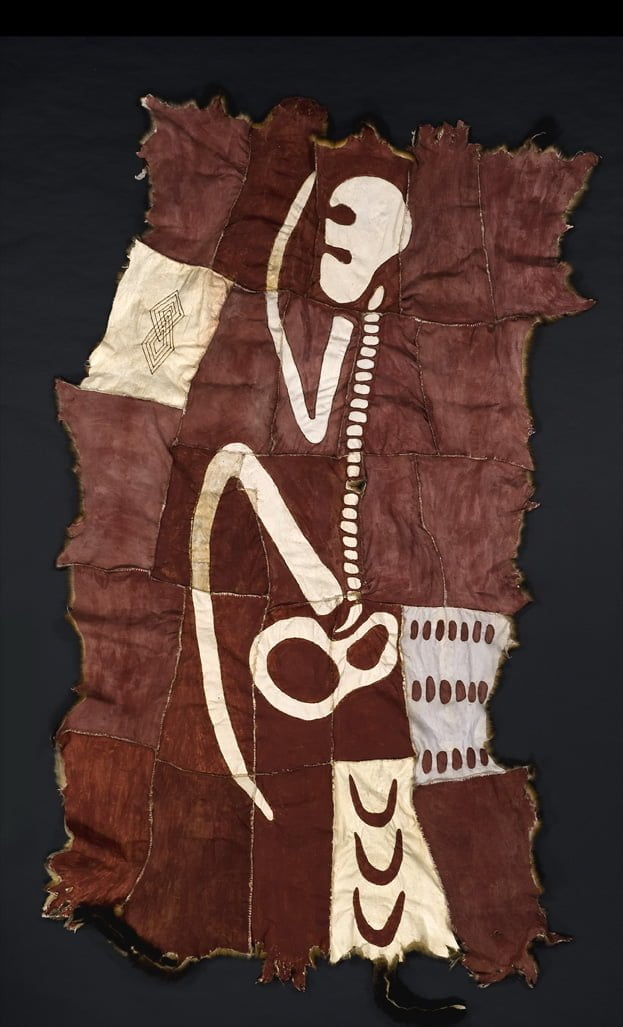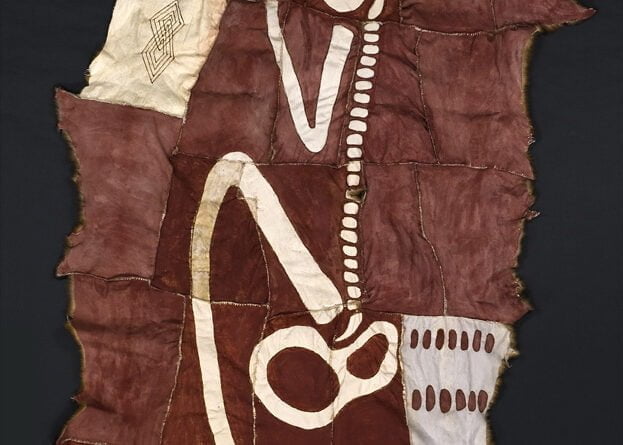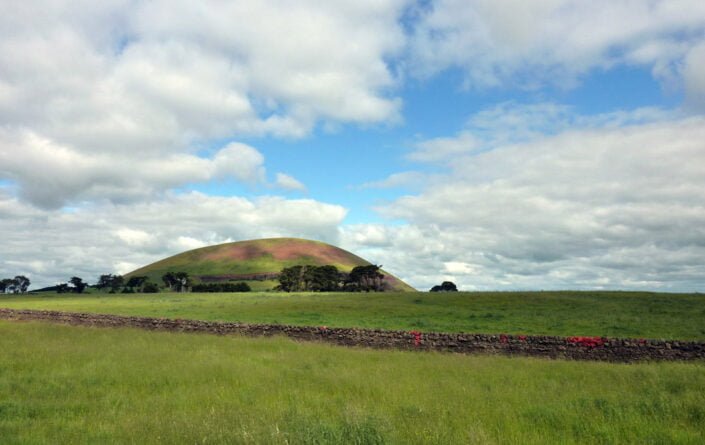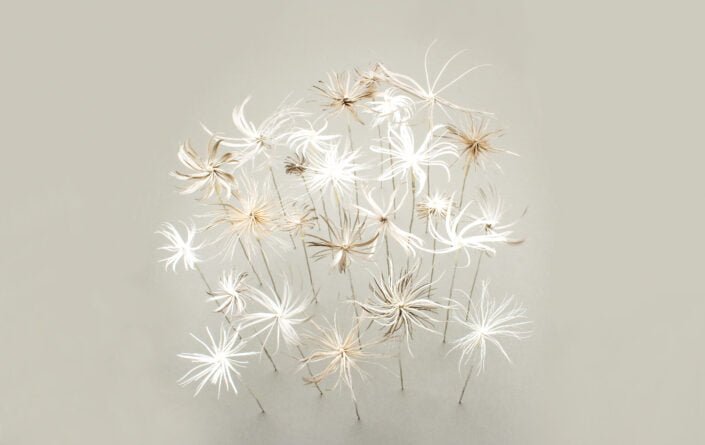Vicki Couzens
The Lands we walked upon are my Grandmothers’ Country; part of the Dharwurd Wurrong – Gunditjmara.
The Walk was a time of reconnection to ancestral lands and I experienced some powerful moments on the journey. These were balanced with contemplative times afterwards when I was able to absorb and integrate my experiences. It was a journey across both the outer physical landscape and my inner spiritual landscape.
Coloured with hues from the land and waters, my works are about the landscape and the changes in it as you traverse this Country. They are also about the unseen, what is above and below the surface, in a literal way and also a metaphorical way, relating the unseen to the spiritual.
The markings in the layers of my painting represent the 54 clans of the Gunditjmara language group, many of which have been unspoken for generations. The unseen is also expressed in prints that record the sounds and senses of the walk and in the possum cloak of spiritual places and events.
Vicki Couzens
Land, language and identity are a central focus of Vicki Couzens’ work. It is in this nexus that the past and present are linked. Her works convey a sense of the land as ancestral body with its pervasive stories and histories.
Couzens did not feel the need to document her journey, choosing simply to exist with the landscape, belonging to the land – sensitive to what is felt, sensed, and received. Like eddies in the current of forgetting, these works reference endangered local species of flora and fauna, indigenous languages and traditional cultural practices almost lost since colonisation, and reaffirm the ceremonial connection to land.
Interview with Vicki Couzens
How would you describe your artistic practice from concept to making?
Images/feelings arise through my inner vision and I get an idea and draw it; a very rough sketch; then it will sit for a while and be ‘distilled’ in the back of my mind – I will think about colour, texture etc. and then often that is it; when I am ready I will just paint it or draw straight onto the plate for printing.
I did the painting first almost straight away after the Walk. This then sat for nearly 12 months before I got around to doing the prints and then the cloak last of all, just before it was all due to be packed and crated. The most scary bit, which turned out to be so easy in the end, was getting the cloak ready to be hung. We ended up finding a furrier who stitched the loops onto the top of the cloak [on] the absolute last day it had to be crated up for touring. (Very last minute that bit, phew!) All good in the end though!
Why did you choose to be involved in the Great South West Walk Art Project?
I was invited and I loved the concept overall. It was an exciting opportunity to walk my Ancestors’ Country (and especially my Grandmother). Also, I
had been working really hard and thought it would be an ideal way to unwind, relax and get back to nature as I had been working in the city a lot.
Did you have any preconceived ideas or plans for your work before embarking on the Walk? If so, what were they and how did your work
evolve?
The only preconceived notion I had was that I wanted to get to know my Grandmother’s Country and somehow interpret that experience to give people the opportunity to see the Country through an Aboriginal perspective, which builds on what the Great South West Walk already does and that is to care for and appreciate the beautiful country and creatures we live in or with. You were the only artist from the group who did not draw or record your experience on paper.
Is this your usual practice or did the Walk bring about a new direction?
I did do a couple of very rough, minor sketches but then gave up on that process as it just wasn’t happening for me. I did think maybe I should be doing more drawing ‘cos everyone else was but as I said just gave up on that process as it’s not me. I don’t do much recording or concept drawings as usual practice. And I felt on this project that I didn’t particularly want or need to. My way is more of experiencing, feeling, sensing, listening, watching [and] then interpreting those feelings, senses, experiences as they arise in my inner vision. Generally I get a sense of the message or story I want to tell and then images can emerge. In this body of work my overall theme is ‘unseen’. The Walk along with this question has made me look more closely at what is my practice and then to try and articulate. That has been good for me; good learning about how I go about things. You have been instrumental in recently reviving the possum skin cloak-making tradition of your ancestors. Can you please describe the process of making your cloak for the Walk exhibition, koorrookee koorramook (Grandmother Cloak), and your intention for this work. With this cloak I wanted to honour my Ancestors of this Country and especially my Grandmother’s. This cloak, as in other cloaks, depicts some aspects of sites on Country – the Glenelg River, the Inkpot site. It also is about those other ‘unseen’ things such as the Red-tailed Black Cockatoo, Spotted Quoll, and basket grass, which are ‘unseen’ to most people. They are also literally rare and ‘unseen’ or hard to seeIn [regard to] the making of the cloak, I cut and stitched this together first and then burnt the designs on with a pokerwork tool, generally used for burning designs onto wood. Usually I burn designs then stitch together but I wanted to do the river and thought I would try a different way this time. I also cut off the tails and heads, which I haven’t done before and used ochre to colour my cloak. Using ochre or paint is something that I have been thinking about for a long time and have never gotten around to or felt like it was the right time to use it until I made this cloak. I used a red ochre colour pigment mixed with wattle sap mixed in water. This is a traditional method of using ochre. Red ochre denotes the special or sacred. I wanted to imply the sacred and spiritual through the use of the reddish colour (although some is pinkish really).
Pokerwork on skin is a new innovation; that is it was not how we traditionally decorated the skins of a cloak. In the old way we would incise the skins with patterns that depicted clan and Country with a sharpened mussel shell or stone implement. We learnt to do the pokerwork from seeing a kangaroo skin that Aunty Nola Kerr (now passed on) had created a number of years ago. This pokerwork method also looks better as you see the designs clearer than when incising, which is more subtle. The designs are important for telling stories about who you are and where you belong to; the designs in the old way, show your Country, sites, special places, places that you and/ or your clan were connected to and responsible for; so when you were wearing your cloak others could tell who and where you belonged to. We source the skins from New Zealand because possums are protected in Victoria and not allowed to be hunted. Also they come already tanned and ready to use so that makes it easier as well. We usually use about 25-36 skins in a cloak depending on what we think is appropriate for that particular cloak.
What is it about the Great South West Walk that inspires you?
The Country inspired me. To spend time immersed in the Country even in the short times I did, was inspiring. I have much to learn of that Country though. I only learnt a little but some of that was profound. I felt a definite message from the ‘Old People’ in the ‘unseen’ theme.
What did you hope to capture in your work?
The theme of the ‘unseen’ was a definite direction from the ‘Old People’ to try and get people to recognise the Country, to learn it and appreciate it; to look in a different way and see our presence, the Aboriginal presence in the Land; how we are there still, and the plants, the creatures and we humans are all connected. The theme ‘unseen’ is layered with levels of meaning. It refers directly to endangered or extinct animals and plants to the spiritual connection of our mob with Country; of the Ancestors who are still present in the Country, watching over it, guarding it, looking after it.
2007The Lands we walked upon are my Grandmothers’ Country; part of the Dharwurd Wurrong – Gunditjmara.
The Walk was a time of reconnection to ancestral lands and I experienced some powerful moments on the journey. These were balanced with contemplative times afterwards when I was able to absorb and integrate my experiences. It was a journey across both the outer physical landscape and my inner spiritual landscape.
Coloured with hues from the land and waters, my works are about the landscape and the changes in it as you traverse this Country. They are also about the unseen, what is above and below the surface, in a literal way and also a metaphorical way, relating the unseen to the spiritual.
The markings in the layers of my painting represent the 54 clans of the Gunditjmara language group, many of which have been unspoken for generations. The unseen is also expressed in prints that record the sounds and senses of the walk and in the possum cloak of spiritual places and events.
Vicki Couzens
Land, language and identity are a central focus of Vicki Couzens’ work. It is in this nexus that the past and present are linked. Her works convey a sense of the land as ancestral body with its pervasive stories and histories.
Couzens did not feel the need to document her journey, choosing simply to exist with the landscape, belonging to the land – sensitive to what is felt, sensed, and received. Like eddies in the current of forgetting, these works reference endangered local species of flora and fauna, indigenous languages and traditional cultural practices almost lost since colonisation, and reaffirm the ceremonial connection to land.
Interview with Vicki Couzens
How would you describe your artistic practice from concept to making?
Images/feelings arise through my inner vision and I get an idea and draw it; a very rough sketch; then it will sit for a while and be ‘distilled’ in the back of my mind – I will think about colour, texture etc. and then often that is it; when I am ready I will just paint it or draw straight onto the plate for printing.
I did the painting first almost straight away after the Walk. This then sat for nearly 12 months before I got around to doing the prints and then the cloak last of all, just before it was all due to be packed and crated. The most scary bit, which turned out to be so easy in the end, was getting the cloak ready to be hung. We ended up finding a furrier who stitched the loops onto the top of the cloak [on] the absolute last day it had to be crated up for touring. (Very last minute that bit, phew!) All good in the end though!
Why did you choose to be involved in the Great South West Walk Art Project?
I was invited and I loved the concept overall. It was an exciting opportunity to walk my Ancestors’ Country (and especially my Grandmother). Also, I
had been working really hard and thought it would be an ideal way to unwind, relax and get back to nature as I had been working in the city a lot.
Did you have any preconceived ideas or plans for your work before embarking on the Walk? If so, what were they and how did your work
evolve?
The only preconceived notion I had was that I wanted to get to know my Grandmother’s Country and somehow interpret that experience to give people the opportunity to see the Country through an Aboriginal perspective, which builds on what the Great South West Walk already does and that is to care for and appreciate the beautiful country and creatures we live in or with. You were the only artist from the group who did not draw or record your experience on paper.
Is this your usual practice or did the Walk bring about a new direction?
I did do a couple of very rough, minor sketches but then gave up on that process as it just wasn’t happening for me. I did think maybe I should be doing more drawing ‘cos everyone else was but as I said just gave up on that process as it’s not me. I don’t do much recording or concept drawings as usual practice. And I felt on this project that I didn’t particularly want or need to. My way is more of experiencing, feeling, sensing, listening, watching [and] then interpreting those feelings, senses, experiences as they arise in my inner vision. Generally I get a sense of the message or story I want to tell and then images can emerge. In this body of work my overall theme is ‘unseen’. The Walk along with this question has made me look more closely at what is my practice and then to try and articulate. That has been good for me; good learning about how I go about things. You have been instrumental in recently reviving the possum skin cloak-making tradition of your ancestors. Can you please describe the process of making your cloak for the Walk exhibition, koorrookee koorramook (Grandmother Cloak), and your intention for this work. With this cloak I wanted to honour my Ancestors of this Country and especially my Grandmother’s. This cloak, as in other cloaks, depicts some aspects of sites on Country – the Glenelg River, the Inkpot site. It also is about those other ‘unseen’ things such as the Red-tailed Black Cockatoo, Spotted Quoll, and basket grass, which are ‘unseen’ to most people. They are also literally rare and ‘unseen’ or hard to seeIn [regard to] the making of the cloak, I cut and stitched this together first and then burnt the designs on with a pokerwork tool, generally used for burning designs onto wood. Usually I burn designs then stitch together but I wanted to do the river and thought I would try a different way this time. I also cut off the tails and heads, which I haven’t done before and used ochre to colour my cloak. Using ochre or paint is something that I have been thinking about for a long time and have never gotten around to or felt like it was the right time to use it until I made this cloak. I used a red ochre colour pigment mixed with wattle sap mixed in water. This is a traditional method of using ochre. Red ochre denotes the special or sacred. I wanted to imply the sacred and spiritual through the use of the reddish colour (although some is pinkish really).
Pokerwork on skin is a new innovation; that is it was not how we traditionally decorated the skins of a cloak. In the old way we would incise the skins with patterns that depicted clan and Country with a sharpened mussel shell or stone implement. We learnt to do the pokerwork from seeing a kangaroo skin that Aunty Nola Kerr (now passed on) had created a number of years ago. This pokerwork method also looks better as you see the designs clearer than when incising, which is more subtle. The designs are important for telling stories about who you are and where you belong to; the designs in the old way, show your Country, sites, special places, places that you and/ or your clan were connected to and responsible for; so when you were wearing your cloak others could tell who and where you belonged to. We source the skins from New Zealand because possums are protected in Victoria and not allowed to be hunted. Also they come already tanned and ready to use so that makes it easier as well. We usually use about 25-36 skins in a cloak depending on what we think is appropriate for that particular cloak.
What is it about the Great South West Walk that inspires you?
The Country inspired me. To spend time immersed in the Country even in the short times I did, was inspiring. I have much to learn of that Country though. I only learnt a little but some of that was profound. I felt a definite message from the ‘Old People’ in the ‘unseen’ theme.
What did you hope to capture in your work?
The theme of the ‘unseen’ was a definite direction from the ‘Old People’ to try and get people to recognise the Country, to learn it and appreciate it; to look in a different way and see our presence, the Aboriginal presence in the Land; how we are there still, and the plants, the creatures and we humans are all connected. The theme ‘unseen’ is layered with levels of meaning. It refers directly to endangered or extinct animals and plants to the spiritual connection of our mob with Country; of the Ancestors who are still present in the Country, watching over it, guarding it, looking after it.
2007




